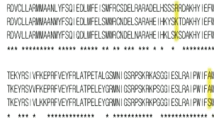Abstract
Two major isofunctional forms of phosphoenolpyruvate carboxylase (EC 4.1.1.31) have been separated from the leaves of Kalanchoe blossfeldiana Poelln. Tom Thumb by acrylamide gel electrophoresis and diethylaminoethyl cellulose techniques: one of the forms prevails under long-day treatment (low crassulacean acid metabolism level), the other develops under short-day treatment (high Crassulacean acid metabolism level). Molecular weights are significantly different: 175·103 and 186·103, respectively. These results indicate that two populations of phosphoenolyruvate carboxylase are present in the plant, one of which is responsible for Crassulacean acid metabolism activity under the control of photoperiod.
The Crassulacean acid metabolism appears to depend on the same endogenous clock that governs other photoperiodically controlled events (e.g. flowering). The metabolic and energetic significance of this feature is discussed. It is suggested that modification in isozymic composition could be an early step in the response to photoperiodism at the metabolic level.
Similar content being viewed by others
Abbreviations
- CAM:
-
Crassulacean acid metabolism
- PEP:
-
phosphoenolpyruvate
- DEAE:
-
diethylaminoethyl
- DTT:
-
dithiothreitol
- LD:
-
long day
- SD:
-
short day
- BSA:
-
bovine serum albumin
References
Brulfert, J., Guerrier, D., Queiroz, O.: Photoperiodism and enzyme rhythms: kinetic characteristics of the photoperiodic induction of Crassulacean acid metabolism. Planta 125, 33–44 (1975)
Brulfert, J., Imhoff, C., Fontaine, D.: Etude comparative de l'induction photopériodique aux niveaux morphogénétique et métabolique. In: Etudes de Biologie Végétale. Hommage au Professeur P. Chouard, pp. 443–455, R. Jacques, ed. Paris 1976
Davis, B.J.: Disc electrophoresis. II. Method and application to human serum proteins. Ann. N.Y. Acad. Sci. 121, 404–427 (1964)
Deleens, E., Garnier-Dardart, J., Queiroz, O.: Isotope composition of intermediates of the starch-malate sequence and level of the Crassulacean acid metabolism in the leaves of Kalanchoe blossfeldiana Tom Thumb. Planta (in press)
Goatly, M.B., Smith, H.: Differential properties of phosphoenolpyruvate carboxylase from etiolated and green sugar cane. Planta 117, 67–73 (1974)
Goatly, M.B., Coombs, J., Smith, H.: Development of C4 photosynthesis in sugar cane: changes in properties of phosphoenolpyruvate carboxylase during greening. Planta 125, 15–24 (1975)
Morel, C., Queiroz O.: Dawn signal as a rhythmical timer for the seasonal adaptive variation of CAM; a model. Plant Cell Environ. 1, 141–149 (1978)
Mukerji, S.K.: Corn leaf phosphoenolpyruvate carboxylase: activation by magnesium ions. Plant Sci. Lett. 2, 243–248 (1974)
Mukerji, S.K., Ting, I.P.: Phosphoenolpyruvate carboxylase isoenzymes: separation and properties of three forms from cotton leaf tissue. Arch. Biochim. Biophys. 142, 297–317 (1971)
Pierre, J.N., Queroz, O.: Regulation of glycolysis and level of the Crassulacean acid metabolism. Planta 144, 143–151 (979)
Queiroz, O., Morel, C.: Photoperiodism and enzyme activity. Towards a model for the control of cricadian metabolic rhythms in the Crassulacean acid metabolism. Plant Physiol. 53, 596–602 (1974)
Skakoun, A., Daussant, J.: Estimation de la taille moléculaire de protéines par électrophorèse en gel de polyacrylamide à gradient de concentration en acrylamide: étude critique de la méthode. Bios. Nancy 11, 503–508 (1972)
Ting, I.P.: Non autotrophic CO2 fixation and Crassulacean acid metabolism. In: Photosynthesis and Photorespiration pp. 169–185, Hatch M.D., Osmond C.B., Slatyer R.O. eds. New York: Interscience 1971
Ting, I.P., Osmond, C.B.: Multiple forms of plant phosphoenolpyruvate carboxylase associated with different metabolic pathways. Plant Physiol. 51, 448–453 (1973)
Vesterberg, O., Svensson, H.: Isoelectric fractionation, analysis, and characterization of ampholytes in natural pH gradients. IV. Further studies on the resolving power in connection with separation of myoglobins. Acta Chem. Scand. 20, 820–834 (1966)
Vidal, J., Cavalié, G.: Mise en évidence de formes isofonctionnelles de la PEP carboxylase chez Phaseolus vulgaris L. Physiol. Vég. 12, 175–188 (1974)
Vidal, J., Cavalié, G., Gadal, P.: Etude de la phosphoenolyruvate carboxylase du haricot et du sorgho par électrophorèse sur gel de polyacrylamide. Plant Sci. Lett. 7, 265–270 (1976)
Willert, D.J., Treichel, S., Kirst, G.O., Curdts, E.: Environmentally controlled changes of phosphoenolpyruvate carboxylase in Mesembryanthemum. Phytochemistry 15, 1435–1436 (1976)
Wilkinson, M.J., Smith, H.: Properties of phosphoenolpyruvate carboxylase from Bryophyllum fedtschenkoi leaves, and fluctuations in carboxylase activity during the endogenous rhythm of carbon dioxide output. Plant Sci. Lett. 6, 319–324 (1976)
Author information
Authors and Affiliations
Rights and permissions
About this article
Cite this article
Brulfert, J., Arrabaça, M.C., Guerrier, D. et al. Changes in the isozymic pattern of phosphoenolpyruvate. Planta 146, 129–133 (1979). https://doi.org/10.1007/BF00388222
Received:
Accepted:
Issue Date:
DOI: https://doi.org/10.1007/BF00388222




